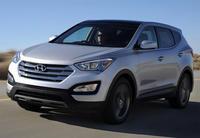2013 Hyundai Santa Fe GLS (7 Passenger) FWD Review By John Heilig
THE AUTO PAGE
By John Heilig
Model: 2013 Hyundai Santa Fe GLS FWD
Engine: 3.3-liter V6
Horsepower/Torque: 290 hp m@ 6,400 rpm
Transmission: 6-speed automatic with Shiftronic
Wheelbase: 110.2 in.
Length x Width x Height: 193.1 x 74.2 x 66.9 in.
Tires: P235/60R18
Cargo: 40.9/80.0 cu. ft. (rear seat up/down)
Economy: 18 mpg city/25 mpg highway/23.4 mpg test
Fuel capacity: 18.8 gal.
Curb Weight: 5,512 lbs.
Sticker: $30,280 (includes $845 inland freight, $1,085 in options)
The Bottom Line: The 7 passenger 2013 Hyundai Santa Fe is completely redesigned and the result is a compact SUV that is smooth, comfortable and roomy.
Hyundai held a regional introduction for the redesigned Santa Fe and the Sonata Hybrid. Due to timing constraints, I was only able to drive the Santa Fe. We drove the vehicle from New York City up into Westchester County and back, about 100 miles. When I got back home after the ride and drive, I picked up my vehicle of the week, a Nissan Pathfinder, for my drive home. What a difference.
While the vehicle of the week was a renowned midsize sport utility that was a fun drive, it paled in comparison with the Santa Fe. The Hyundai offered a more comfortable ride, more power and better handling than the Pathfinder. And that isn’t even in the competition mix for the Santa Fe.
The third generation Santa Fe is offered in three trim levels – the 5-passenger Sport, the 7-passenger GLS and the 6-passenger Limited. We drove the front-wheel drive GLS. The Limited and GLS are built on a 110.2-inch wheelbase, while the Sport is built on a 106.3-inch wheelbase. There’s a corresponding 8.5-inch difference in overall length.
Dimensionally, the Santa Fe compares well with midsize SUVs, although it’s listed as a compact crossover. Yet Hyundai places it among a “primary competitive set” including the Honda Pilot, Toyota Highlander and Pathfinder, and a secondary set of Ford Explorer and Mazda CX-9. A distinct advantage for the Santa Fe is Hyundai’s fluidic sculpture styling that adds shaping to the sides and adds a level of distinction and individuality to the vehicle.
We drove the Santa Fe on a couple of long trips in which, according to the onboard computer, fuel economy reached as high as 28.5 mpg. Overall we averaged 23.4 mpg, factoring on local driving. The 3.3-liter V6 in the GLX offered good power, with 290 horses and 262 lb.-ft. of torque. We were never at a loss for power.
The engine was quiet at all speed, except, of course, when we tromped down on the accelerator and asked for a lot. But I challenge anyone to have silent operation when your right foot is on the floor.
The heated front seats have enough side support to help. They also make long drives comfortable. Second row seats offer excellent leg and knee room. There’s a low center hump so a third passenger could ride there comfortably. Second row seats slide and tilt for third row access. The third row seats fold easily with just a pull on the strap hanging down. The strap also helps restore the seats back to their original position from their folded flat position.
The third row seats don’t have a lot of padding, which makes them easier to fold. They’d be ideal for child booster seats. Also, with the kids further back you can’t hear them screaming as well.
Even with the third row seats up there’s excellent cargo capacity in the back. There’s also some cargo capacity under the floor.
Among the standard safety features are hillstart assist, downhill brake control, brake assist and traction control. A full menu of equipment packages is available for the two top models.
Base prices for the Santa Fe start at $24,450 for the FWD Sport and range all the way to $37,750 for the Limited AWD with the Technology package.
Altogether, the Hyundai Santa Fe has obviously benchmarked the competition and used that process to make the vehicle as competitive as possible. They did a good job.
© 2013 The Auto Page



